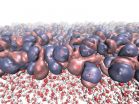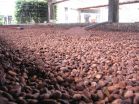Decreased red blood cell clearance predicts development and worsening of serious diseases
Understanding mechanism behind previously observed biomarker could improve disease diagnosis, prognosis
2015-04-20
(Press-News.org) Massachusetts General Hospital (MGH) investigators have found the probable mechanism underlying a previously described biomarker associated with the risk of developing serious diseases ranging from cancer to cardiovascular disease and the risk of serious complications. In a paper published in the American Journal of Hematology, the research team reports finding that higher levels of a measure routinely taken as part of the complete blood count - the extent of variation in the size of red blood cells - is caused by reduced clearance of aging cells from the bloodstream. Hundreds of studies since 2007 have found that elevations in this measure - called RDW for RBC (red blood cell) distribution width - predicted the development, progression and risk of death from many conditions.
"It appears that the human body slightly slows down the production and destruction of red blood cells in just about every major disease," says John Higgins, MD, MGH Center for Systems Biology and Department of Pathology, senior author of the report. "If we can accurately measure the production or destruction rates, we might be able to identify many of these diseases in their earlier stages when they are most treatable. Existing measures of the production rate are far too imprecise to detect these subtle changes, but this paper shows how the destruction rate can be estimated using existing blood count data and a mathematical model."
Healthy adults generate red blood cells at a rate of more than two million per second, and the cells circulate in the bloodstream for 100 to 120 days, during which their size decreases by around 30 percent. Aged red blood cells are then cleared at about the same rate of two million per second. Prior to the reports associating an elevated RDW with increased risk for many diseases, that measure had only been used to help distinguish between different forms of anemia. In their effort to understand the correlation between RDW and disease prognosis, the MGH team analyzed raw data from more than 60,000 randomly selected blood samples from the hospital's clinical laboratories, using a mathematical model developed by Higgins and a colleague to replicate how red blood cell populations behave differently in health and in disease.
Using this model to measure the extent to which red blood cells in different phases of their life cycle contribute to increased RDW they found that the variance in size was strongly determined by mild increases in the numbers of the smallest and oldest cells. Since the most important mechanism controlling the number of the oldest cells is the rate at which they are cleared from the blood stream, the research team made several predictions, which were validated by applying their model to clinical data from the MGH blood samples and to data from several published studies:
increased RDW was associated with delayed red blood cell clearance,
increased RDW was associated with increased average age of red blood cells,
delayed red blood cell clearance was as strongly associated with overall risk of death as was increased RDW,
delayed red blood cell clearance was associated with the presence of early signs of hidden diseases associated with increased RDW,
patients with delayed red blood cell clearance had a greater risk of developing signs of those diseases in the future than did those with a typical clearance rate,
in healthy patients the rate of red blood cell clearance varied less than did any other traditional blood-count characteristic.
Higgins notes that there are many potential clinical applications of these findings, which need to be validated by future studies. "Finding a reduced clearance rate in an apparently healthy person would likely mean that an underlying disease process was developing - such as the early stages of iron deficiency, kidney disease, colon cancer or congestive heart failure - and would warrant further diagnostic evaluation. Based on this analysis of routine blood tests, a primary care physician could immediately consider appropriate follow-up diagnostic testing, instead of waiting for other signs and symptoms to appear as the condition progresses. In a patient with established disease, a reduced clearance rate could mean progression of disease or treatment failure, and imminent complications could be avoided or reduced by adjusting treatment right away or at least by more frequent monitoring.
"In addition to confirming our findings in prospective studies that would follow a group of patients over time, we hope to identify the diseases for which an early warning provided by delayed clearance would lead to the most significant improvements in patient outcomes," he continues. "We'd also like to understand more about the processes controlling red blood cell clearance and are actively developing similar models for populations of white blood cells and platelets."
INFORMATION:
Higgins is an assistant professor of Systems Biology at Harvard Medical School. The co-authors of the American Journal of Hematology paper are lead author Harsh Patel and Hasmukh Patel, both of the MGH Center for Systems Biology and Department of Pathology. The study was supported by National Institute for Diabetes and Kidney Disease grant K08DK083242, National Institutes of Health Director's New Innovators Award DP2DK098087 and Abbott Hematology.
Massachusetts General Hospital, founded in 1811, is the original and largest teaching hospital of Harvard Medical School. The MGH conducts the largest hospital-based research program in the United States, with an annual research budget of more than $760 million and major research centers in AIDS, cardiovascular research, cancer, computational and integrative biology, cutaneous biology, human genetics, medical imaging, neurodegenerative disorders, regenerative medicine, reproductive biology, systems biology, transplantation biology and photomedicine.
ELSE PRESS RELEASES FROM THIS DATE:
2015-04-20
When you take a medication for, say, high cholesterol, do you know that pill is really what the label says it is? Depending upon the type of medicine and where you live, the threat of falsified medications (also referred to as counterfeit, fraudulent, and substandard) can be quite real, yet the full scope and prevalence of the problem is poorly understood, say researchers at University of California, San Diego School of Medicine in a new report published April 20 in the American Journal of Tropical Medicine and Hygiene.
Counterfeit medicines have traditionally been defined ...
2015-04-20
DURHAM, N.C. -- While the female baboon's big red bottom may be an eyesore to some, it has an aphrodisiac effect on her mates. Biologists have long thought that baboon males prefer females with bigger backsides as the mark of a good mother, but new research suggests it isn't so simple.
A study of wild baboons in southern Kenya reveals that the size of a female's swollen rump doesn't matter as much as previously thought.
The study appears online in the journal Animal Behaviour.
Baboons breed throughout the year, and mating occurs during times when a female's behind ...
2015-04-20
ALEXANDRIA, VA, APRIL 20, 2015 - Higher-than-expected rates of pediatric cancers have been identified in the Miami metro area and an area west of the Everglades in a series of five statistical analyses conducted for Science and Public Policy, an open-access, online public-policy journal published by the American Statistical Association (ASA).
In a review of the analyses for Science and Public Policy, Lance A. Waller, a biostatistics professor specializing in spatial epidemiology at Emory University in Atlanta, urges care in next steps, recommending that state and local ...
2015-04-20
WASHINGTON, April 20, 2015 -- Wednesday, April 22 large-scale use of chemical weapons in warfare. Some of the best minds in chemistry at that time, including a Nobel Prize winner, used their knowledge of science to build humanity's new weapons of mass destruction. Reactions presents this sobering look at the chemistry behind the modern world's first chemical weapons. Check out the video here: http://youtu.be/e8W3dOURya0.
Check out all of C&EN's great coverage of the 100th anniversary of chemical weapons at http://chemicalweapons.cenmag.org.
INFORMATION:Subscribe to ...
2015-04-20
PITTSBURGH--As people find ever more inventive uses for smartphones, touchscreens sometimes fall short as control surfaces. Researchers at Carnegie Mellon University and Disney Research have developed an inexpensive alternative - a toolbox of physical knobs, sliders and other mechanisms that can be readily added to any device.
The researchers drew inspiration from wind instruments in devising these mechanisms, which they call Acoustruments. The idea is to use pluggable plastic tubes and other structures to connect the smartphone's speaker with its microphone. The device ...
2015-04-20
ATLANTA -April 20, 2015- Despite strong evidence and guidelines supporting its use, post-surgical radiation therapy for prostate cancer patients at risk of recurrence is declining in the United States. The study, published online in the journal European Urology, finds fewer than 10 percent of patients at risk of recurrence received postoperative radiotherapy within six months of surgery in the U.S.
Although radical prostatectomy (RP) is a common curative treatment for localized prostate cancer, about 30% of patients will develop biochemical recurrence after surgery, ...
2015-04-20
The National Physical Laboratory (NPL), the UK's National Measurement Institute in collaboration with IBM and the University of Edinburgh, has used a new quantum model to reveal the molecular structure of water's liquid surface.
The liquid-vapour interface of water is one of the most common of all heterogeneous (or non-uniform) environments. Understanding its molecular structure will provide insight into complex biochemical interactions underpinning many biological processes. But experimental measurements of the molecular structure of water's surface are challenging, ...
2015-04-20
The discovery of a gene involved in determining the melting point of cocoa butter -- a critical attribute of the substance widely used in foods and pharmaceuticals -- will likely lead to new and improved products, according to researchers in Penn State's College of Agricultural Sciences.
The finding by plant geneticists also should lead to new varieties of the cocoa plant that could extend the climate and soil-nutrient range for growing the crop and increase the value of its yield, they said, providing a boost to farmers' incomes in the cocoa-growing regions of the world.
Cacao, ...
2015-04-20
Singapore, 20 April 2015 - Since the discovery of graphene about a decade ago, scientists have been studying ways to engineer electronic band gaps in the material to produce semiconductors which can create new electronic devices. A team of researchers from Yale-NUS College, the Center for Advanced 2D Materials and Department of Physics at the National University of Singapore (NUS) and the University of Texas at Austin, USA (UT Austin) have established a theoretical framework to understand the elastic and electronic properties of graphene. The findings were published in ...
2015-04-20
As two galaxies enter the final stages of merging, scientists have theorized that the galaxies' supermassive black holes will form a "binary," or two black holes in such close orbit they are gravitationally bound to one another. In a new study, astronomers at the University of Maryland present direct evidence of a pulsing quasar, which may substantiate the existence of black hole binaries.
"We believe we have observed two supermassive black holes in closer proximity than ever before," said Suvi Gezari, assistant professor of astronomy at the University of Maryland and ...
LAST 30 PRESS RELEASES:
[Press-News.org] Decreased red blood cell clearance predicts development and worsening of serious diseases
Understanding mechanism behind previously observed biomarker could improve disease diagnosis, prognosis




